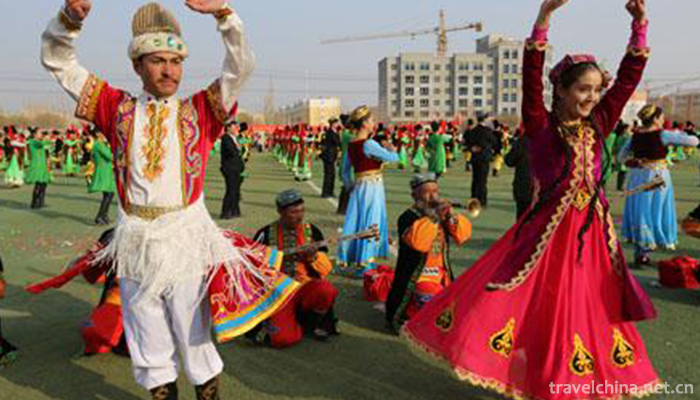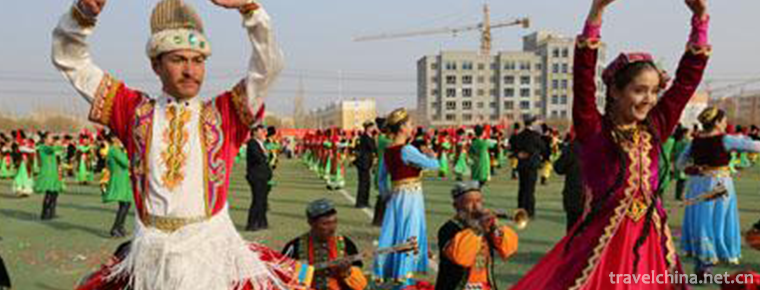Sama Dance
Sama Dance
Sama dance is a kind of folk dance that the Uygur working people dance together during the New Year's Festival. Its movements are simple and powerful. It is mainly popular in Kashgar and Shache of Southern Xinjiang.
May 23, 2011 was listed in the third batch of national intangible cultural heritage list by the State Council.
Historical Evolution
Samaben is the name of a primitive religion, which was once believed by the ancient Uygur people. At that time, due to the extremely backward productivity, people prayed for the harvest of hunting and agriculture to various gods of nature in the form of songs, drums and dances under the organization of full-time priest, Sama.
With the development of productivity and the change of economic life, it has gradually evolved from sacrificial rituals to collective entertainment activities during the working people's New Year's Day, and then to a unique form of folk dance. In addition to the New Year's Day, Sama dances are sometimes performed on general occasions of celebration. Sama dances and music are also absorbed in the beginning of the third part of the twelve Muqam, Messilev.
After the introduction of Islam into Xinjiang, the rulers also used Sama as a folk dance form for religious activities. For example, the action of raising both hands is interpreted as "Huda (God) in heaven" and the action of holding one hand to the chest is interpreted as "Huda is in the heart".... Although Sama dances are played by suona and drums, no laughter is allowed. The mood of the dancers and the atmosphere of the dance are solemn and solemn. The Sama held in the Temple House had no music. With the prayer of Amu, she was dancing and shouting rhythmically "Ooh - Ooh!" But in the folk entertainment occasions, when people dance Sama, they are still full of happy atmosphere. After liberation, they jumped more vigorously. ?
Dance features
In the early morning of Kurban Festival, the crisp sound of iron drums drifted to thousands of families along with the warm morning breeze. People dressed in costumes poured from all directions to the Plaza of the Great Church Temple to celebrate traditional festivals. Everyone danced the Samar dance with the clear and powerful Samar tune and the rhythm of the iron drum. Dancers follow the counter-clockwise direction, with the drum point "thump" strong tone to start, and gradually the rhythm turns fast, the drum sound becomes more powerful, the movement also turns to fierce and enthusiastic, many people began to do Sama dance unique continuity of jumping and other technical movements. The audience and the dancers echoed each other, and the mood became higher and higher. Finally, the dance ended in a jubilant chorus.
Most of the participants were men and sometimes women, but all of them danced together by themselves. Samar dancing is steady and solid, full of the breath of labor and life.
The movements of Sama dance and the rhythm of drums are closely coordinated. "Bah" time is mostly full foot landing, stable and powerful, not rigid and not immediately raised, with the effect of a note. When the power leg is lifted, the knee of the main leg has obvious flexion and extension, and the body undulates greatly. ?
Most of the hands are semi-clenched fists in natural form, which have obvious leisureliness when they are thrown open and bent back. With the swing of the hand, the body has the feeling of slightly shaking left and right. One-step skipping, one-step skipping, one-step skipping and so on are common skills in Sama. ?
Samar has a special tune. It usually starts with the familiar music of Mukam or Thanem, and then turns to Samar as the rhythm of the drum changes.
The music rhythm of Sama Dance is vigorous and powerful, and it has its own characteristics. Basically, it can be divided into the following rhythms:
The main instruments accompanying Sama are Suona and drum. The number of suonas varies. The drum is composed of two drums with different pitches, which produce the sound of "thump" and "dang", forming a sharp contrast. In large occasions, sometimes there are two or three groups, plus a bigger drum with more rich timbre, highlighting the sound effect of "drum". The rhythm of drum determines the harmony and unity of dance speed and movement. Experienced drummers make the drumbeating varied and inspire the mood of the dancers and the audience. Suona plays a more flexible tune, not limited by the drum, sometimes dragging two or three bars of long notes, or three or four bars of intervals to highlight the rhythm of the drum.
Current status of protection
Kashgar "Samar Dance" was listed in the third batch of national intangible cultural heritage list by the State Council on May 23, 2011. It is the only national intangible cultural heritage protection project in Kashgar. It is listed as the five major citizens along with the Uygur traditional "Saim Dance", "Daolang Dance", "Shadiana Dance" and "Nazurkumu" dance. One of the dances between Uygurs is the most representative group dance for celebration.


-
1.Stirfried Shrimps with Longjing Tea Leaves
Lobwell shrimp is a famous Hangzhou dish with a strong local flavor. It is made of lobwell tea and shrimp before and after the Qingming Festival.
Time 2018-10-27 -
2.Free and unfettered hu hot soup
The authentic Xiaoyao Town Hu Hot Soup, produced in Xiaoyao Town, Xihua County, Zhoukou City, Henan Province, is a famous snack in China
Time 2018-11-26 -
3.The Oriental Pearl Radio & TV Tower
The Oriental Pearl Radio and Television Tower is one of the landmark cultural landscapes in Shanghai. It is located in Lujiazui, Pudong New Area, with a height of 468 meters
Time 2018-12-05 -
4.Huanglong Scenic Area
Huanglong Scenic Spot, World Natural Heritage, World Human and Biosphere Reserve, Green Globe 21 Certificate, National AAAAA Tourist Spot, National Key Scenic Spot.
Time 2018-12-12 -
5.Yunnan Nationalities Village
Located in the southwest suburb of Kunming City, Yunnan Province, Yunnan Ethnic Village covers 89 hectares. It is a window reflecting and displaying the social and cultural customs
Time 2018-12-22 -
6.Yangda Kuduktur Beacon Platform Site
Beacon also known as beacon platform, beacon platform, Yandun, pyrotechnic platform. If there were enemies, smoke in the daytime and fire in the evening were the quickest and most effective ways to tr
Time 2019-03-02 -
7.Forty eight Zhai Song Festival
The forty-eighth Village Song Festival is a northern Dong dialect Song Festival in Tianzhu County, Guizhou Province, China. It is a traditional national festival featuring Dong
Time 2019-05-01 -
8.Hanju Opera
Han Opera, a local traditional drama in Wuhan, Hubei Province, is one of the national intangible cultural heritage.
Time 2019-05-02 -
9.Lion Lamp in Jinggangshan Hall
"Quantang Lion Lantern" is a traditional Wushu athletic project spread in Huzhaoping Village, Shangxiang, Jinggang, Shandong Province. It has nearly 200 years history.
Time 2019-05-08 -
10.Qianjiang Folk Songs
Qianjiang folk song is a traditional folk song in Hubei Province. Popular in Qianjiang City, folk songs created by local working people in their work, life and customs. Its rich content,
Time 2019-06-10 -
11.Empress Dowager Ci Xi
Ci Xi (November 29, 1835 - November 15, 1908) is the queen of Xiao Qin chin. Yehiel Bernard La Shi, Xianfeng Emperor Concubines, Tongzhi Emperor The birth mother. Important in late Qing Dynasty Politi
Time 2019-09-07 -
12.Yibin scenic spot
South Sichuan Bamboo Sea is a national AAAA tourist attraction, covering an area of 120 square kilometers and a core scenic area of 44 square kilometers. There are eight main scenic areas, two major scenic spots and 134 scenic spots. In 2009, it was se
Time 2020-12-18